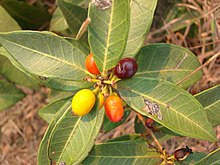Eugenia calycina
| Eugenia calycina | |
|---|---|

| |
| Fruiting Eugenia calycina plant | |
| Scientific classification | |
| Kingdom: | Plantae |
| Clade: | Tracheophytes |
| Clade: | Angiosperms |
| Clade: | Eudicots |
| Clade: | Rosids |
| Order: | Myrtales |
| Family: | Myrtaceae |
| Genus: | Eugenia |
| Species: | E. calycina
|
| Binomial name | |
| Eugenia calycina Cambess. (1832) | |
| Varieties | |
|
Eugenia calycina var. herbacea ( | |
| Synonyms | |
| |
Eugenia calycina, also known as savannah cherry, field cherry, Jabuti cherry, Grão de galo, cerejinha, cereja do cerrado, pitanga-vermelha, red pitanga, cherry of the Cerrado, and ca-ajaboti, is a flowering
Distribution
Eugenia calycina is native to Brazil, including but not exclusive to the states of Goiás, São Paulo, Minas Gerais, Mato Grosso do Sul, and Paraná.[2] It grows wild in savannahs and fields up to 1,600 meters (5,200 feet) in elevation, especially in drier areas.[1]
Description
Eugenia calycina grows up to 2 meters (6.6 feet) in height, although is normally between 0.7 and 1.5 meters (2.3 and 4.9 feet). The narrow,
Uses
The fruit is often gathered from the wild and eaten raw or made into jellies and sweets.[1] It is used by native people to treat diabetes.[5]
Chemistry
The fruit is rich in
See also
References
- ^ a b c "Eugenia calycina - Useful Tropical Plants". tropical.theferns.info. Retrieved 13 March 2021.
- ^ "Eugenia calycina Cambess". www.gbif.org. Retrieved 13 March 2021.
- ^ a b "Eugenia calycina and punicifolia". www.bananasraras.org. Retrieved 13 March 2021.
- ^ "Savanna Cherry Eugenia Calycina Dark Red Fruit Tropical Tree Plant RARE". eBay. Retrieved 13 March 2021.
- ^ PMID 33233178.
- S2CID 221127361. Retrieved 13 March 2021.
- PMID 25108373. Retrieved 14 March 2021.
